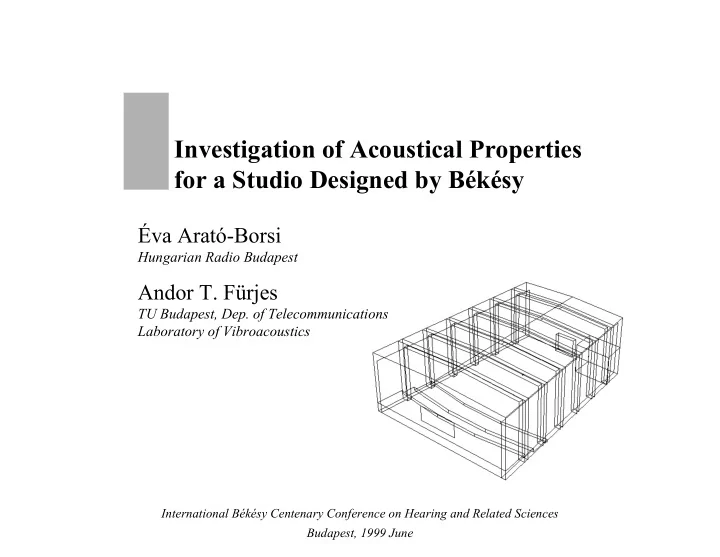

Investigation of Acoustical Properties for a Studio Designed by Békésy Éva Arató-Borsi Hungarian Radio Budapest Andor T. Fürjes TU Budapest, Dep. of Telecommunications Laboratory of Vibroacoustics International Békésy Centenary Conference on Hearing and Related Sciences Budapest, 1999 June
Hungarian Radio Budapest 2 Contents Introduction The Studio Measured Objective Parameters Results Conclusions International Békésy Centenary Conference on Hearing and Related Sciences Budapest, 1999 June
Hungarian Radio Budapest 3 3 Introduction The investigation of an existing studio … assist to obtain an evaluation of the room acoustic properties of the studio The relationship between the objective and subjective side… new objective parameters Parameters for concert halls … studio acoustics International Békésy Centenary Conference on Hearing and Related Sciences Budapest, 1999 June
Hungarian Radio Budapest 4 4 The Studio The studio was designed by Békésy, - inaugurated in 1935, - Classical music studio and rehearsal room for the Symphony Orchestra of the Hungarian Radio Geometry - sizes: 19m x 16.2m x 7.2m - area: 300m 2 - volume: 2160 m 3 19m International Békésy Centenary Conference on Hearing and Related Sciences Budapest, 1999 June
Hungarian Radio Budapest 5 5 The History In general The aim is to design a room with required subjective quality. At that time there was only one objective parameter: reverberation time, defined by Sabine (the time for the -60 dB attenuation of the received energy) Békésy began the design with thoroughness. Finding the optimal value of the reverberation time: - Subjective investigations changing the reverberation time of the studio step by step. - Subjects musicians, teschers of music, experts of Radio, music fans. International Békésy Centenary Conference on Hearing and Related Sciences Budapest, 1999 June
Hungarian Radio Budapest 6 6 The History (2) Illustration of the phenomenon: - reverberant condition <> very damped condition - changing the absorbing cover to find the most favourable reverberation time Comparison of measured and proposed RT RT (s) f (Hz) measured values with given tolerance International Békésy Centenary Conference on Hearing and Related Sciences Budapest, 1999 June
Hungarian Radio Budapest 7 7 Measured Objective Parameters Using only RT is insufficient, more parameters are needed based on the impulse response: - reverberation time (RT) - early decay time (EDT) - centre time (t s ) - clarity (C) - support (ST) Reverberation Time (RT) - from measured time between -5…-35dB attenuation - mean value: RT M =0.93s International Békésy Centenary Conference on Hearing and Related Sciences Budapest, 1999 June
Hungarian Radio Budapest 8 8 Measured Objective Parameters (2) EDT - a novel measure of reverberation time - emphasizes the subjective importance of the early part of the reverberation process (10 dB interval of the decay) - measured value: EDT=0.82s - high value indicates much reverberance and low clarity or vice versa. Centre Time (t s ) - the centre of gravity of the energy distribution ∞ ∫ ( ) ⋅ 2 t p t dt [ ] S = 0 t sec ∞ ∫ ( ) 2 p t dt 0 International Békésy Centenary Conference on Hearing and Related Sciences Budapest, 1999 June
Hungarian Radio Budapest 9 9 Measured Objective Parameters (3) Clarity - ratio of received energy before and after a specified time point, given in dB t E ( , ) 0 t ( ) 1 = ∫ ( ) [ ] = ⋅ 2 C t 10 lg dB E t t , p ( ) t dt where ∞ E t ( , ) 1 2 t 2 - usually C( 40msec ) or C( 80msec ) is evaluated Support (ST1, ST2) In concert halls this gives the ratio between the early reflection energy sent back to the platform and the energy of the direct sound in dB. E ( 20 100 , ms ) E ( 20 200 , ms ) [ ] [ ] = ⋅ lg = ⋅ lg ST 10 dB ST 10 dB 1 2 E ( , 0 10 ms ) E ( , 0 10 ms ) International Békésy Centenary Conference on Hearing and Related Sciences Budapest, 1999 June
Hungarian Radio Budapest 10 Evaluation of the Measured Results The measured values t s (ms) C 40 (dB) C 80 (dB) ST1 (dB) ST2 (dB) h1,m1 33,8 5.7 8.88 -2.54 -1.31 h1,m2 42.1 7.6 10.52 2.01 3.1 h1,m3 64.6 3.46 6.57 3.6 5.06 34.9 7.5 10.4 2.29 3.34 h2,m3 h2,m2 48.4 5.6 8.83 3.54 4.75 To find the optimal values of the new objective parameters for different type of studios, ...more subjective tests have to be carried out. International Békésy Centenary Conference on Hearing and Related Sciences Budapest, 1999 June
Hungarian Radio Budapest 11 Conclusions New objective parameters to qualify the acoustical parameters of a room More possibilities to predict the acoustical behaviour of the studios using computer modelling To find the optimal values of the objective parameters, extensive research work is needed
Recommend
More recommend